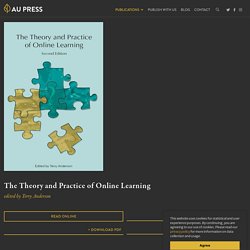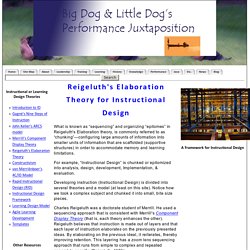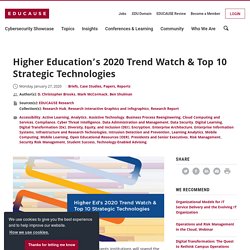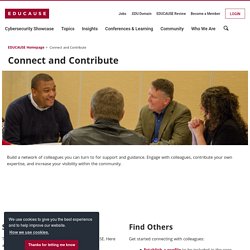

Seven Ways of Learning. The seven ways of learning. Learning Theories - InstructionalDesign.org. The Theory and Practice of Online Learning - Athabasca University Press. In this important collection of essays by practitioners and scholars that has been downloaded nearly half a million times is an overview of some of the most pressing issues in online education.

By addressing transformations arising from educational technology advances and the new business conditions and modes of delivery of education, the contributors to The Theory and Practice of Online Learning provide insights into this complex, diverse, and rapidly evolving field. Awards. Summaries of Learning Theories and Models - Learning Theories. Why Educators Need to Know Learning Theory. This is the second in a three-part series about Learning Design. The first post introduced the Learning Design Framework; a guide for educators to create optimal learning experiences for students by leveraging: 1) content resources, 2) collaborative web resources and 3) human resources.
This second post focuses on learning theory and how it applies to not only course design, but educators’ role in creating excellent learning experiences for their students. Note: this is a revised version of a post that appeared on January 19, 2014. We need to study learning theory so we can be more effective as educators. In this post I bridge the gap between learning theory and effective educators; describe why we need to start at A to get to B. Moodle. Videos: Learning Theories, Instructional Design Theories, & Instructional Design Models. Instructional or Learning Design. What is known as “sequencing” and organizing “epitomes” in Reigeluth's Elaboration theory, is commonly referred to as “chunking”—configuring large amounts of information into smaller units of information that are scaffolded (supportive structures) in order to accommodate memory and learning limitations.

For example, “Instructional Design” is chunked or epitomized into analysis, design, development, Implementation, & evaluation. Developing instruction (Instructional Design) is divided into several theories and a model (at least on this site). Notice how we took a complex subject and chunked it into small, bite size pieces. Firstprinciplesbymerrill. Robert Gagné's Nine Steps of Instruction. According to Robert Gagné (1985) there are nine events that provide a framework for an effective learning process: While Gagnés Nine Steps are often treated as iron clad rules, it has been noted for quite some time that the nine steps are more like a framework or guidelines: “[Gagnés nine steps are] general considerations to be taken into account when designing instruction.

Although some steps might need to be rearranged (or might be unnecessary) for certain types of lessons, the general set of considerations provide a good checklist of key design steps” (Good, Brophy, 1977). The Nine Steps. Instructional design in higher education report 5129d9d1e6c988c254567f91f3ab0d2c. Instructional Designer Competencies - Welcome to ibstpi. Copyright Guidelines: The ibstpi® Standards Sets (Competencies and Performance Statements), whether in English or another language, are covered by copyright laws and intellectual property standards.

Therefore, should you wish to share and/or distribute the Standards with anyone, in any format (digital, paper copies, etc.), you must seek permission to from ibstpi® to do so. ibstpi® Standards Sets, containing the associated competencies and performance statements, are not to be published in any form, on any public, private, or internal websites that can be accessed by any member of the public, inside or outside of your organization, without prior explicit permission from ibstpi®. Higher Education’s 2020 Trend Watch & Top 10 Strategic Technologies. This research examines technological investments institutions will spend the most time implementing, planning, and tracking in 2020, as well as the related trends that could influence institutional IT strategy.

Report | Other materials Key Findings The trends and technologies reviewed in this report were identified through an EDUCAUSE survey conducted in the summer of 2019 and completed by 312 US institutions. 25 Ed Tech Predictions for 2021. Education Trends 25 Ed Tech Predictions for 2021 Education technology may have come into its own during the pandemic.

But will it remain front and center forever? Teaching and Learning Edition. This report profiles key trends and emerging technologies and practices shaping the future of teaching and learning and envisions a number of scenarios and implications for that future.

It is based on the perspectives and expertise of a global panel of leaders from across the higher education landscape. Read full report: PDF | Other materials The Future of Teaching and Learning. The Future of L&D: 5 Learning Trends for 2021. “In 2021, success will be measured by how well we can target the right learning opportunities,” says Joanna Miller, learning and development lead at Asana.

“We need to curate them at the right depth, at the right time in the employee journey—all in service of helping employees filter options to make the right choices to drive their growth forward.” L&D leaders are faced with the challenge of delivering a wide range of employee learning experiences that are personalized, fuel career growth, and help retain great talent. To deliver these outcomes, leaders need to be smart with their time, leverage key cross-functional partnerships, and dial into innovative ways to increase learning opportunities at every level.
We’ll explore the top five learning trends in 2021 with the leaders at Zoom, Asana, Fivetran, Intercom, and The People Piece. 1. Instructional Design Community Group. Blended and Online Learning Community Group. Diversity in IT Community Group. Instructional Technologies Community Group. Connect and Contribute. There are many ways to get involved with EDUCAUSE.

Here are a few opportunities to consider: Join EDUCAUSE Community Groups to get advice, share expertise, and build knowledge and professional networks. Get more involved by reaching out to CG leaders and volunteering to lead CG conversations.Participate in a working group. Working groups are a great way to work closely with peers and provide useful resources for the higher education community.Serve on an advisory or program committee and build relationships with peers while contributing your expertise to EDUCAUSE programs and events.Volunteer to be a proposal reviewer for EDUCAUSE events. Submit a proposal for EDUCAUSE events.Become an EDUCAUSE author -- write a guest blog or article for EDUCAUSE Review, publish a Research Bulletin, or contribute to a 7 Things You Need to Know About. Sign Up. Learning and Development. eLearning Industry - Post your eLearning article. At eLearning Industry you will find the best collection of eLearning articles, eLearning concepts, eLearning software, and eLearning resources.
The Learning Guild. Membership Is Free Find Your Community Join an established community of professionals dedicated to designing, developing, and sharing their work through valuable discussions and connections.

Follow Your Passion Be empowered to create better learning experiences through accessible resources that help reach your goals and advance our industry by working together. Advance Your Work. SHIFT eLearning Blog. Moodle. Instructional Design Central (IDC) Canvas Instructional Designers - Instructure Community. Elearning Home - eLearning. Articulate E-Learning Heroes Community. Home - Blackboard Community. All courses. Understanding by Design. Overview Understanding by Design is a book written by Grant Wiggins and Jay McTighe that offers a framework for designing courses and content units called “Backward Design.”
Instructors typically approach course design in a “forward design” manner, meaning they consider the learning activities (how to teach the content), develop assessments around their learning activities, then attempt to draw connections to the learning goals of the course.